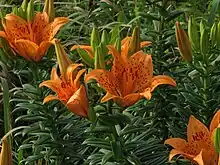| Lilium maculatum | |
|---|---|
 | |
| Scientific classification | |
| Kingdom: | Plantae |
| Clade: | Tracheophytes |
| Clade: | Angiosperms |
| Clade: | Monocots |
| Order: | Liliales |
| Family: | Liliaceae |
| Subfamily: | Lilioideae |
| Tribe: | Lilieae |
| Genus: | Lilium |
| Species: | L. maculatum |
| Binomial name | |
| Lilium maculatum | |
| Synonyms[1] | |
Lilium maculatum (スカシユリ/透百合[3]/透かし百合[4], sukashi-yuri, "see-through lily") is a plant in the lily family native to Japan.
Etymology
Its Japanese name is sukashi-yuri, literally "see-through lily" or perhaps "openwork lily", originates from the gaps between its tepals.[4]
The plant is also called iwato-yuri or iwa yuri referring to its rocky habitat, or hama yuri from growing on the seashore.[5]
In the Japanese horticultural trade, cultivated types are referred to as sukashiyuri while the wild-growing ones are called iwatoyuri.[6] Furthermore, plants growing along the Pacific Ocean are called iwatoyuri, distinguished from iwayuri that grow on the coasts of the Sea of Japan.[6]
Range
Lilium maculatum is native to the central and northern regions of Japan, widely cultivated as an ornamental.[1][7][8][9]
The perennial plan grows on sandy seashores, rocky areas, or cliff-tops.[6]
General description
.jpg.webp)
It is a stem rooting lily,[2][11] its bulbs are ovate and white, lacking bitterness. Parts of the scales on the bulb may be jointed.[6] The stalk grows from 20 to 60 centimetres (7.9 to 23.6 in) tall,[6][12] and bears a number of orange, red, or yellow flowers with darker spots.[2][12] Sometimes the yellow lilies exhibit spotlessness[13]
In Japan, plants growing on the Pacific coast (iwatoyuri) bloom from the latter half of June until early August, much later than the lilies on the coasts of the Sea of Japan (iwayuri) that bloom from the latter half of May to early June.[6]
This species used to be considered one of the more important in food consumption as lily bulb or yuri-ne (ユリ根) around the turn of the 20th century.[14][15]
Varieties
- Recognized cultivars[1]
- Lilium maculatum var. bukosanense (Honda) H.Hara
- Lilium maculatum var. maculatum
The variety bukosanense (Japanese: miyamasukashi-yuri) was originally discovered on Mount Bukō in Saitama Prefecture near Tokyo, with scattered populations later found in Ibaraki Prefecture.[6] The variety is unusual, as it is a "hanging" or "weeping" type with a pendulous stem,[16] but is listed as critically endangered by Saitama's Red Data Book.[16] The mountain has been heavily quarried for limestone by the cement industry, which now collaborates in the plant's conservation efforts in captivity; foraging by wildlife such as the Japanese macaque is also thought to jeopardizes its survival.[17]
Japanese literature c. 1900 writes of several yellow varieties grown which had no spots,[18][lower-alpha 1] but a warning was written against their export, while only spotted or lightly spotted varieties of these yellow lilies were being shipped to the West.[21] Years later, the spotless yellow lilies were still considered few and elusive.[13]
- Formerly included[1]
- Lilium maculatum subsp. dauricum (Ker Gawl.) H.Hara, now considered a synonym of Lilium pensylvanicum Ker Gawl.
- Lilium maculatum var. monticola H.Hara, now considered a synonym of Lilium maculatum var. maculatum
Explanatory notes
References
- Citations
- 1 2 3 4 Kew World Checklist of Selected Plant Families
- 1 2 3 Cullen, James; Knees, Sabina G.; Cubey, H. Suzanne; Shaw, J. M. H., eds. (2011). The European Garden Flora Flowering Plants. Cambridge University Press. p. 94. ISBN 978-0-521-76147-5.
- ↑ Shin shikunshi (1901), p. 75.
- 1 2 "Sukashi-yuri すかし‐ゆり【透かし百合】", Kojien, 4th ed., 1991. "下半各花被片の間に空隙があるところから命名。"
- ↑ Shimizu (1960), p. 111.
- 1 2 3 4 5 6 7 Satake, Yoshisuke [in Japanese] (1981). Nihon no yasei shokubutsu:sōmoku 日本の野生植物: 草本. Heibonsha. p. 321. ISBN 978-4-876-45399-3.
- ↑ Thunberg, Carl Peter (1794) Transactions of the Linnean Society of London 2: 334 (in Latin).
- ↑ Tropicos, Lilium maculatum Thunb.
- ↑ Pacific Bulb Society, Lilium Dauricum Section color photos of several species including numerous color photos of Lilium maculatum
- ↑ Plate 39 of Elwes, Henry John (1880) A monograph of the genus Lilium ... illustrated [with coloured plates] by W.H. Fitch, London, Taylor & Francis OCLC: 560210827.
- ↑ Miller, Wilhelm (September 1907). "A Perfect Combination―Rhododendrons and Lilies". Country Life in America. 12 (5): 534.
- 1 2 Brickell, Christopher (2019). Encyclopedia of Plants and Flowers. Penguin. p. 625. ISBN 978-1-465-49896-0.
- 1 2 Skinner, F. L. (1946). "New Lilies From Manitoba". The American Lily Year Book. American Horticultural Society: 106.
- ↑ Dai Nihon Nōkai [in Japanese] (1895). Useful Plants of Japan Described and Illustrated. Agricultural Society of Japan. p. 27.
- ↑ Shin shikunshi (1901), p. 75, p. 132.
- 1 2 Arzate‐Fernández, A. M.; Miwa, M.; Shimada, T.; Yonekura, T.; Ogawa, K. (2005), "Genetic diversity of Miyamasukashi‐yuri (Lilium maculatum Thunb. var. bukosanense), an endemic and endangered species at Mount Buko, Saitama, Japan", Plant Species Biology, 20 (1): 57–65, doi:10.1111/j.1442-1984.2005.00124.x; Arzate‐Fernández et al. (2007) "In vitro propagation of miyamasukashi-yuri (Lilium maculatum Thunb. var. Bukosanense), an endangered plant species", Revista Fitotecnia Mexicana 30 (4), pp. 373–379.
- ↑ "Miyamasukashi-yuri Ken zetsumetsu kigushu, kichō na sugata Bukōsan de satsuei Jisei kakunin wa nanajū-ku-nen irai" ミヤマスカシユリ 県絶滅危惧種、貴重な姿 武甲山で撮影 自生確認は79年以来 /埼玉. Mainichi Shimbun. local issue (Saitama). 2016-08-16.
- ↑ Inoue, Ryūtarō (1894), "Sukashi-Yuri (Lilium elegans Thunb.) and its Origin", Lily Yearbook, Ryūtarō Inoue: 5–
- ↑ Shin shikunshi (1901), pp. 76–77.
- ↑ Shimizu, Moto'o (June 1957), "Nihon no yuri 日本の百合", Shizenkagaku to hakubutsukan 24 (1/2), p. 7
- ↑ Shin shikunshi (1901), pp. 77–78.
- Bibliography
- Shimizu, M[oto'o] (1960). "Sukashi-Yuri (Lilium elegans Thunb.) and its Origin". Lily Yearbook. North American Lily Society (13): 105–120.
- "yuri ユリ", in Nihon shakai jii 日本社會事彙 (in Japanese). Vol. 2. Keizai zasshi-sha. 1908. pp. 2077–2083., digested from Shin shikunshi (1901) .
- Seika-en Sanjin 精花園山人 "Hana-yuri 花百合", in Shōkadō Shujin (1901), Shin shikunshi 新四君子 (in Japanese), Tokyo Mita Ikushujyo, pp. 63–140